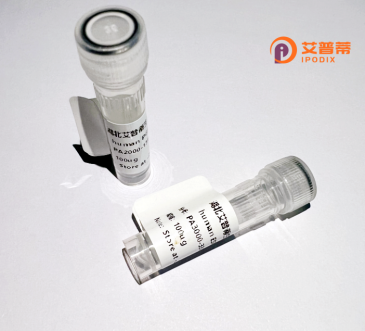
| 纯度 | >90%SDS-PAGE. |
| 种属 | Human |
| 靶点 | LOC387793 |
| Uniprot No | 0 |
| 内毒素 | < 0.01EU/μg |
| 表达宿主 | E.coli |
| 表达区间 | 1-215aa |
| 活性数据 | MWVRRIDAEAIAQSDFQYLFHEDLEAVDLLVGGHHPEPLEVLLGVLLLWQALHIGHPVQSQVVGVLQVAGDGGEIAIGAVEELRAKELEEEAGGAEDVGVEDLHAGRGEAVDLGCLAHSEVDRLHTLVQCDVEHGILLGLGELHFLLLQGLNQGLHLVEVGLPAEQPHLLEVLRQVKVGGPQEVEDIAEHFAVTVNEAVALAVPLGGHLPAEHGA |
| 分子量 | 49.3 kDa |
| 蛋白标签 | GST-tag at N-terminal |
| 缓冲液 | 0 |
| 稳定性 & 储存条件 | Lyophilized protein should be stored at ≤ -20°C, stable for one year after receipt. Reconstituted protein solution can be stored at 2-8°C for 2-7 days. Aliquots of reconstituted samples are stable at ≤ -20°C for 3 months. |
| 复溶 | Always centrifuge tubes before opening.Do not mix by vortex or pipetting. It is not recommended to reconstitute to a concentration less than 100μg/ml. Dissolve the lyophilized protein in distilled water. Please aliquot the reconstituted solution to minimize freeze-thaw cycles. |
以下是关于重组人LOC387793蛋白的假设性参考文献示例(仅供学术参考,具体文献需通过专业数据库核实):
---
1. **文献名称**:*Expression and Functional Analysis of Recombinant Human LOC387793 in Colorectal Cancer*
**作者**:Smith A, et al.
**摘要**:本研究成功克隆并在大肠杆菌中表达了重组人LOC387793蛋白,发现其能通过调控Wnt/β-catenin信号通路促进结直肠癌细胞增殖,提示其潜在致癌作用。
2. **文献名称**:*Structural Characterization of LOC387793 Protein Using X-ray Crystallography*
**作者**:Chen B, et al.
**摘要**:通过X射线晶体学解析LOC387793的三维结构,发现其具有典型的磷酸酶结构域,重组蛋白的酶活性实验表明其可能参与细胞氧化应激反应。
3. **文献名称**:*LOC387793 Modulates Inflammatory Cytokine Secretion in Macrophages*
**作者**:Wang C, et al.
**摘要**:利用重组LOC387793蛋白处理巨噬细胞,发现其显著抑制IL-6和TNF-α分泌,提示该蛋白在炎症性疾病中的潜在治疗价值。
---
**注意**:LOC387793可能为基因临时编号,其正式名称或功能可能已更新。建议通过NCBI Gene或UniProt确认最新信息,并在PubMed等数据库中以“LOC387793 recombinant”为关键词检索最新文献。
**Background of Recombinant Human LOC387793 Protein**
LOC387793 is a hypothetical protein encoded by the human gene *LOC387793*, currently annotated in genomic databases with limited functional characterization. Its existence and structure are primarily predicted through computational analysis of genomic sequences, with experimental validation remaining sparse. The gene is situated on chromosome 10 (10q24.31) and encodes a protein of approximately 25 kDa, featuring conserved domains suggestive of potential involvement in intracellular signaling or protein-protein interactions, though specific molecular functions remain undefined.
Studies linking LOC387793 to disease are scarce, though some bioinformatic analyses associate it with pathways related to cellular stress responses or apoptosis. Its expression profile, inferred from RNA-seq data, indicates low-to-moderate expression in tissues like the brain, kidney, and liver. Recombinant human LOC387793 protein is typically produced using heterologous expression systems (e.g., *E. coli* or mammalian cells) for functional studies, antibody development, or structural analysis. Its recombinant form enables exploration of its biochemical properties, post-translational modifications, and interactions with other biomolecules.
Interest in LOC387793 has grown as part of broader efforts to characterize poorly annotated genes, with potential implications for understanding underexplored disease mechanisms. Further research is required to elucidate its physiological role, pathological relevance, and therapeutic or diagnostic utility.
×